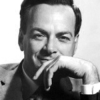Richard P. Feynman

Richard P. Feynman
Richard Phillips Feynmanwas an American theoretical physicist known for his work in the path integral formulation of quantum mechanics, the theory of quantum electrodynamics, and the physics of the superfluidity of supercooled liquid helium, as well as in particle physics for which he proposed the parton model. For his contributions to the development of quantum electrodynamics, Feynman, jointly with Julian Schwinger and Sin-Itiro Tomonaga, received the Nobel Prize in Physics in 1965...
NationalityAmerican
ProfessionPhysicist
Date of Birth11 May 1918
CountryUnited States of America
Richard P. Feynman quotes about
I would rather have questions that can't be answered than answers that can't be questioned.
What I cannot create, I do not understand.
I think, however, that there isn't any solution to this problem of education other than to realize that the best teaching can be done only when there is a direct individual relationship between a student and a good teacher - a situation in which the student discusses the ideas, thinks about the things, and talks about the things. It's impossible to learn very much by simply sitting in a lecture, or even by simply doing problems that are assigned. But in our modern times we have so many students to teach that we have to try to find some substitute for the ideal.
I have a friend who's an artist, and he sometimes takes a view which I don't agree with. He'll hold up a flower and say, "Look how beautiful it is," and I'll agree. But then he'll say, "I, as an artist, can see how beautiful a flower is. But you, as a scientist, take it all apart and it becomes dull." I think he's kind of nutty. [...] There are all kinds of interesting questions that come from a knowledge of science, which only adds to the excitement and mystery and awe of a flower. It only adds. I don't understand how it subtracts.
You have no responsibility to live up to what other people think you ought to accomplish. I have no responsibility to be like they expect me to be. It's their mistake, not my failing.
Science is like sex: sometimes something useful comes out, but that is not the reason we are doing it
If you think you understand quantum mechanics, you don't understand quantum mechanics.
God was invented to explain mystery. God is always invented to explain those things that you do not understand.
I, a universe of atoms, an atom in the universe.
No government has the right to decide on the truth of scientific principles, nor to prescribe in any way the character of the questions investigated. Neither may a government determine the aesthetic value of artistic creations, nor limit the forms of literacy or artistic expression. Nor should it pronounce on the validity of economic, historic, religious, or philosophical doctrines. Instead it has a duty to its citizens to maintain the freedom, to let those citizens contribute to the further adventure and the development of the human race.
No problem is too small or too trivial if we can really do something about it.
Physics is to math what sex is to masturbation.
My rule is, when you are unhappy, think about it. But when you're happy, don't. Why spoil it? You're probably happy for some ridiculous reason and you'd just spoil it to know it.
I am a successful lecturer in physics for popular audiences. The real entertainment gimmick is the excitement, drama and mystery of the subject matter. People love to learn something, they are 'entertained' enormously by being allowed to understand a little bit of something they never understood before. One must have faith in the subject and in people's interest in it.